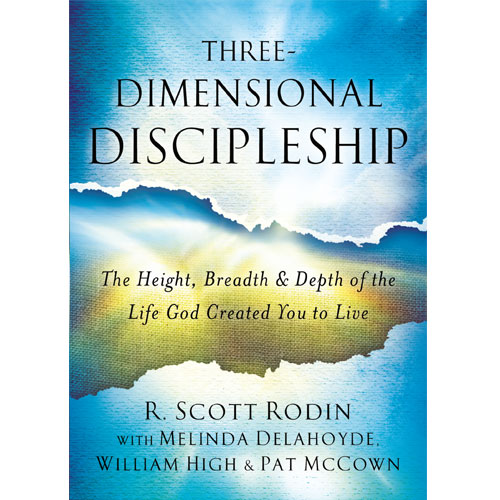What is Holistic Stewardship?
At the 2007 Christian Stewardship Association conference in Dallas I spoke about “holistic stewardship” and many people asked me how I defined the term.
To me, holistic stewardship begins with God’s intention for His creation and His gracious decision to create humanity in God’s image. It is built further on the central Christian tenet that the God in whose image we have been created is the God we know in Jesus Christ. God’s self-revelation to us in Jesus Christ is the core of our faith, giving it direction and substance. Our faith assures us that we know our God with certainty, and it is by knowing God in Jesus Christ that we can embrace our call to reflect the image of God. As such, it is a clear and joyous, albeit difficult calling.
We also know that the God that has been revealed to us in Jesus Christ is a Triune God. We were created to bear the image of a God who is, in His very nature, community, fellowship, and interdependence. This triune nature of God, combined with the knowledge that we were created in His image, leads us to one significant conclusion—you and I were created for relationship. Relationship defines what it means to be created in the image of God. The way that we know God is as Father, Son, and Holy Spirit—eternally three and eternally one. And this God created us in his own image that we might bear God’s image as we live in relationship.
This one central teaching dictates the way you and me are to live. It shapes our priorities in life and brings to the center the role of relationships and community. Our identity as children of the Triune God lies in our lives lived in and through community in holistic relationship mutually interdependent and seeking the unity of the spirit. That is how we reflect the image of a Trinitarian God. This life glorifies God because that is precisely why we were created.
Bearing the Image
In Genesis we find that we were created for whole relationships that reflect the image of God on four levels. First, we were created for intimate relationship with God. This is our first and highest calling and joy.
We were created for relationship with our self—to have absolute certainty of who we are, why we are here, and what we are to do. This self understanding was a part of God’s loving intent for us when he created humanity in His image.
We were created for relationship with our neighbor; to love our neighbor as we love ourselves. We were created to see our neighbors and their well-being in the same way we see our own, which calls us to value relationships as ends, not means, to our own benefit.
Last, we were created for a relationship with creation. God’s command is that we “have dominion, rule over and subdue” the earth just as God has dominion, rules over, and subdues us. This requires us to live in harmony with creation; to love it, to tend it, to take care of it.
As Adam and Eve lived out those four levels of relationship they reflected the image of God, and so do we. But of course the story does not end there. We know that when sin entered into the world it had a devastating impact on our relationship with God. However, too often we have limited the effects of the Fall to apply only to our relationship to God. Here we must be sure to continue our commitment to think theologically and holistically.
The Image Lost and Restored
In the fall of Adam and Eve into sin we lost our relationship with God. Sin caused separation from God that could only be overcome by the blood of Christ. The God known in intimacy and fellowship became the holy and terrible God who was now only approachable through ritual sacrifice, human mediation, and a constant need for a repentant heart that seeks unmerited forgiveness.
We also experienced the loss of relationship with ourselves. Adam and Eve lost their primary purpose of life—tending the garden, loving one another, and fellowshipping freely with God as his beloved creation. The central theme of the history of humanity became our search to get back what was lost, to find God again, and be at peace with creation and our Creator. We are all on a search to recapture intimacy with God and certainty as to our purpose and meaning in life that was lost in the Fall.
We saw the rise of enmity with our neighbor. Adam blamed Eve, Eve blamed the serpent, and the first story that comes after the fall is Cain’s killing of Abel. Thus begins “man’s inhumanity to man.” This inhumanity is a product of the dethroning of God and the coronation of the Self as the primary driving force in our lives. This replacement of God with Self is the core definition of the impact of sin in our lives.
In this original sin we see the rise of our conflict with creation. It is after the fall that “dominion” was redefined as domination, “rule over” became own and control, and “subdue” became the justification to exploit. It is a postfall understanding of these words that have yielded the grossly mistaken assumption that the earth is ours to use any way we want.
We must understand the profound and devastating effects of sin on all four levels if we are to embrace a holistic definition of stewardship, and the subsequent role of Christian fundraising.
Praise be to God that the restoration Christ accomplished through his own blood was even more holistic than the affect of the fall. Paul tells us that although one sin brought this into the world, how much more the blood of Christ covers all sin. (Romans 5:9-15) He also proclaims that, “As in Adam all men died, even so in Christ have all been made alive.” (1 Cor. 15:22) And we are assured that while sin brought condemnation on the one man, so the blood of Christ brings redemption for all humanity (Romans 5:12-15). In short, all that was lost in the fall was fully and completely restored in Christ!
A holistic understanding of Christ’s atoning work assures us that our relationship with God was reestablished. Through the blood of Christ we have been reconciled to God. Hebrews rejoices that in this newly restored relationship with God in Jesus Christ we now “come with confidence before the throne of grace.” (Hebrews 4:16)
On the second level, Christ came to reclaim for us a holistic understanding of who we are as his children. In Christ we are citizens of His Kingdom. Even more, we are children of the King! As His beloved children, we have a vocation, a future, and a role. We know why we are here, what our purpose is in life, and where we are going. That’s what it means to be a Christian. All that was lost in the Fall has been fully and completely restored to us in Christ.
We have also been reconciled with our neighbor. With the Great Commission, the Great Commandment now calls us back to love one another and to take care of our neighbor. We’ve been called to the ministry of reconciliation, peacemaking, and servanthood. We are able to love our neighbor properly because we can now love ourselves as God’s beloved—and redeemed—creation.
Finally, we have a redeemed relationship with our creation. We see ourselves once again as both the “crown of creation” and one with creation. We are again given back our true calling to care for and rule over the world with a loving and godly rule. This impacts our use of time, talents, and treasures and it calls us into a true stewardship relationship with our environment.
The Godly Steward
What is holistic stewardship? We are stewards of our redeemed and restored relationships on all four levels.
According to this definition we are called first to be stewards of our relationship with God. That means that our worship, reading, and study of the Scriptures, personal devotions, and prayer life are acts of stewardship.
In our redeemed relationship with ourselves we are now caretakers of our understanding who we are as children of the Kingdom of God. This is a delicate balance; we are precious and beloved by God and also humble, thankful, and obedient to his Word. As we maintain that balance with the help of the Holy Spirit, we are stewards of our self-image.
We are also stewards of our relationships with our neighbor. We are called to be in good, whole, right, loving relationships with one another, seeking to love our neighbor as ourselves, working for peace and reconciliation, and serving our neighbors’ physical, emotional, and spiritual needs as the Bible directs us. We are called to make sure that our relationships with one another are never a means but always ends.
Finally, our restored relationship with creation calls us to be stewards of God’s creation and all the material possessions that we have, placing them in the service of one kingdom of Christ.
This is my understanding of what it means to be a godly steward. When we take this more holistic view, we see that worshiping is stewardship. Taking care of how we understand ourselves as children of God is stewardship. Spending time with our neighbor is stewardship. Giving our money to God’s purposes is stewardship. All these areas reflect what was created, lost, and now given back to us in our glorious call to be stewards of these wonderful gifts on all four levels.
The holistic image of the godly steward then is reflecting our creator God through whole, redeemed relationships on all four levels, glorifying God, and practicing in each the ongoing work of the steward.
May God grant us wisdom and courage to live out of this holy calling!
Scott Rodin, CSA President





